ANGELS & DEMONS: Key objects, places, organizations and processes
Table of contents:
- CERN
- The Large Hadron Collider (LHC)
- The Antimatter
- Vatican City
- St. Peter’s Basilica
- The Crypt of St. Peter’s Basilica
- Castel Sant’Angelo
- The Sistine Chapel
- Necropolis
- The papal conclave
- The Pantheon
- Bernini’s sculptures
- Swiss Guards
- The Illuminati
- Ambigrams
- The Path of Illumination and the four elements
- CHURCH OF ILLUMINATION:
CERN
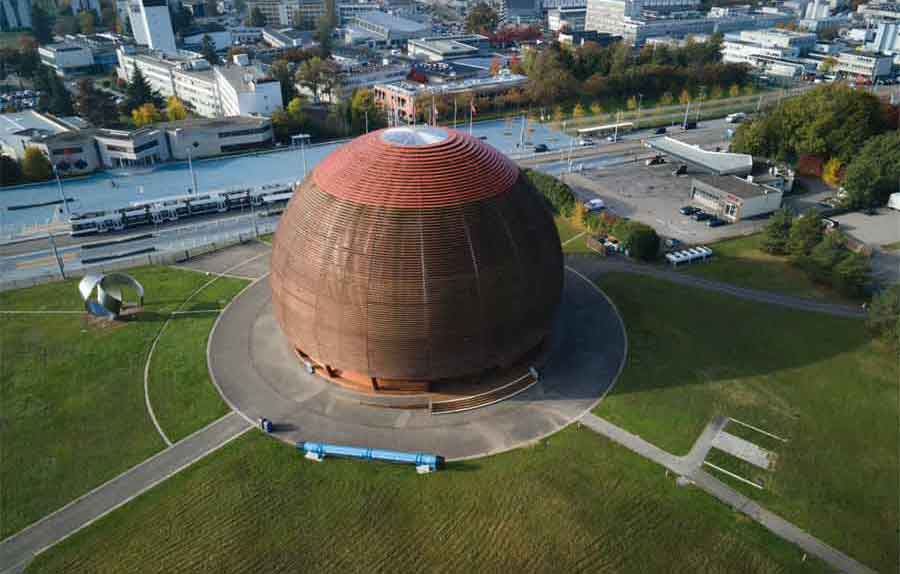
CERN (“Conseil Européen pour la Recherche Nucléaire”, or European Council for Nuclear Research,) is a significant setting in the novel “Angels and Demons”. Dan Brown describes CERN in detail that helps to create a rich and immersive portrayal of this iconic institution. His attention to detail and the scientific accuracy make the novel a fascinating exploration of the intersection of science, technology, and culture in one of the world’s leading research institutions.
(i) CERN is one of the world’s leading research centers for particle physics, and Brown explores the science and technology that is at the heart of the institution. He explains the principles of particle physics, and explores the cutting-edge technologies that are used in CERN’s experiments.
(ii) CERN is known for its distinctive modernist architecture, and Brown provides readers with a detailed description of the building’s design. He explores the sleek lines and minimalist aesthetic of the buildings, as well as the high-tech equipment that is housed within.
(iii) CERN is also a symbol of international cooperation and scientific progress, and Brown explores its historical significance in detail. He explains how the institution was founded and built, and explores the ways in which it has played a crucial role in advancing scientific knowledge and understanding.
The Large Hadron Collider (LHC)
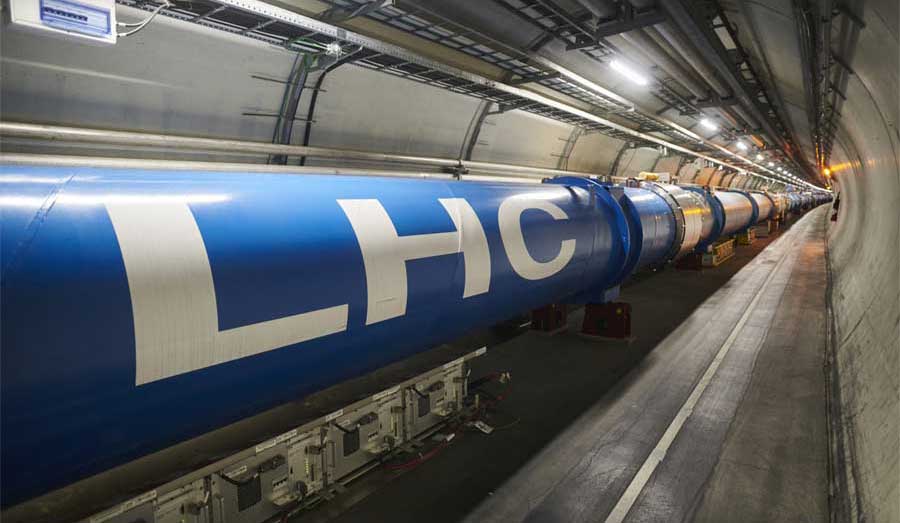
In the novel “Angels and Demons,” Brown’s descriptions of the LHC are detailed and extensive, reflecting the author’s meticulous research and attention to scientific accuracy. The Large Hadron Collider (LHC) is a particle accelerator located underground at CERN in Geneva, Switzerland, and is one of the most complex and advanced scientific instruments in the world, spanning over 27 kilometers in circumference, with thousands of scientists and technicians working tirelessly to unlock the secrets of the universe.
Brown’s descriptions of the LHC’s various components, such as its superconducting magnets, beam pipes, and particle detectors, are highly technical and detailed, providing readers with a sense of the intricate workings of this complex machine. He also explores the scientific theories and discoveries that have been made possible by the LHC, such as the Higgs boson particle and the potential for discovering new dimensions of space and time.
Brown emphasizes the importance of scientific exploration and discovery, as well as the potential benefits and dangers that can arise from pushing the boundaries of human knowledge and understanding.
The Antimatter
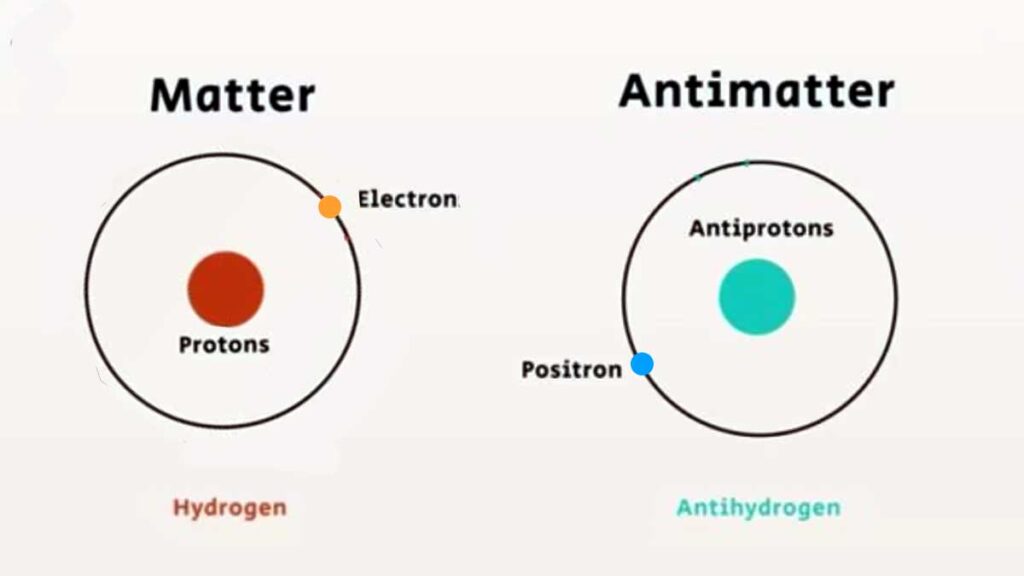
Antimatter is a concept that plays a significant role in “Angels and Demons.”. In simple terms, antimatter is the opposite of matter. It is made up of particles that have the same mass as regular matter but have an opposite charge. When antimatter and matter collide, they annihilate each other, releasing a tremendous amount of energy.
The antimatter in the story is created at CERN. The creation of antimatter in the novel is a highly complex and dangerous process that requires immense amounts of energy. The antimatter is stored in a special containment unit that is designed to keep it stable. However, when the antimatter is stolen, the characters must race against time to recover it before it explodes, causing catastrophic damage. The potential danger of antimatter is emphasized throughout the story, as the characters must navigate through a series of challenges and obstacles to prevent a disaster.
Vatican City
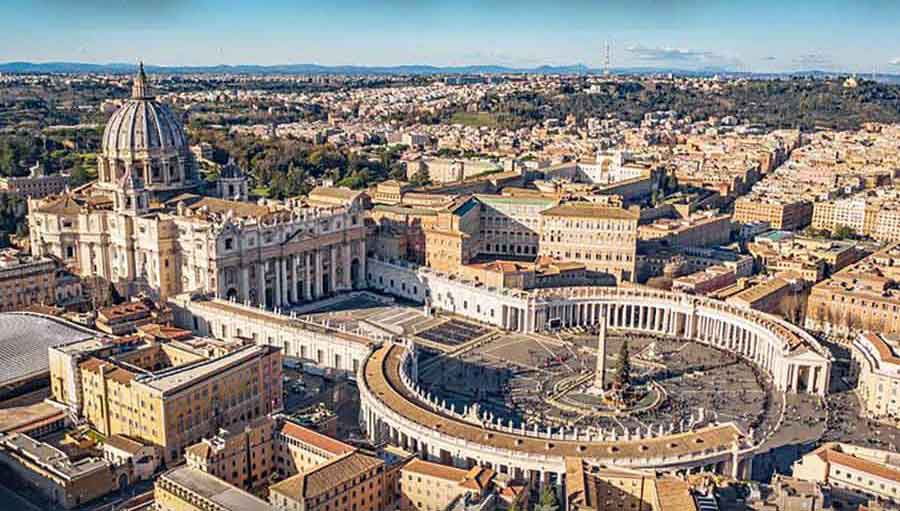
Vatican City is a significant setting in Dan Brown’s novel “Angels and Demons,” and Brown provides readers with a detailed description of this iconic location. Here are some examples of Brown’s use of detailed descriptions of Vatican City in the novel:
Architecture and Design: Vatican City is known for its stunning architecture and iconic landmarks, and Brown provides readers with a detailed description of the buildings and monuments within the city walls. He explores the intricate carvings and decorations on the buildings’ façades, as well as the grandeur of the interior spaces.
History and Significance: Vatican City is the spiritual and administrative center of the Roman Catholic Church, and Brown explores its historical and religious significance in detail. He explains the history of the papacy and the role of the Vatican in shaping the Catholic Church throughout the centuries.
Art and Artifacts: Vatican City is home to some of the world’s most valuable and unique works of art, including paintings, sculptures, and other artifacts. Brown explores these in detail, describing the masterpieces created by some of history’s greatest artists, as well as the religious significance of many of the works.
Dan Brown’s use of detailed descriptions of Vatican City in “Angels and Demons” helps to create a rich and immersive portrayal of this iconic location. His attention to detail and historical accuracy make the novel a fascinating exploration of the intersection of religion, art, and history in one of the world’s most important cultural and religious centers.
St. Peter’s Basilica
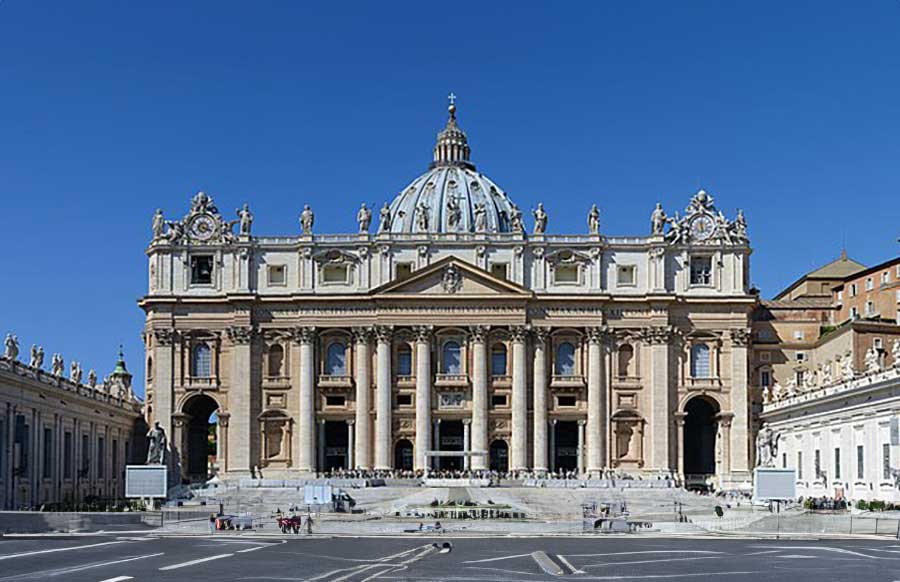
St. Peter’s Basilica is one of the most prominent locations in Dan Brown’s novel Angels and Demons. The basilica is located in Vatican City and is considered one of the holiest Catholic shrines in the world. Here are some descriptions of St. Peter’s Basilica in Angels and Demons:
The novel describes the basilica as a massive structure, with a facade that is more than 300 feet wide and 150 feet tall. The facade is decorated with massive columns and statues, and a large dome sits on top of the building.
Inside the basilica, the novel describes a vast open space, with high ceilings and beautiful decorations. The walls are covered in gold and precious stones, and there are many intricate sculptures and works of art.
The novel also describes the many chapels and altars within the basilica, each dedicated to a different saint or religious figure. One of the most prominent is the Altar of the Chair, which contains a throne that is believed to have been used by St. Peter himself.
The Crypt of St. Peter’s Basilica
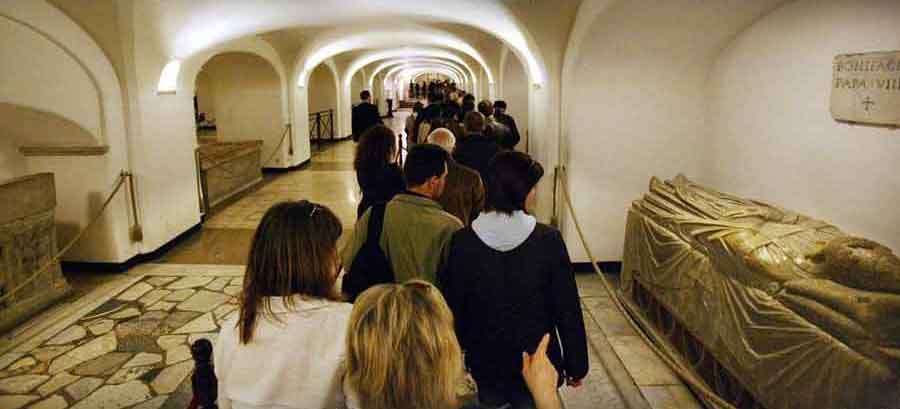
In “Angels and Demons,” the crypt of the Basilica is described as an ancient burial ground beneath St. Peter’s Basilica, located deep beneath the high altar. The crypt is a maze-like structure that spans several levels and is filled with the remains of Popes, saints, and other religious figures.
The crypt is accessed through a secret door on the floor of the Basilica, which leads to a winding staircase. The walls are lined with marble and stone tombs, some of which are adorned with intricate carvings and artwork.
The central focus of the crypt is the tomb of St. Peter, which is located in a circular chamber at the very bottom of the crypt. The tomb is adorned with gold and precious gems, and is said to contain the remains of the Apostle Peter.
Throughout the novel, Langdon and Vittoria navigate the crypt and its various levels as they try to solve the mystery of the Illuminati and prevent the destruction of Vatican City.
Castel Sant’Angelo
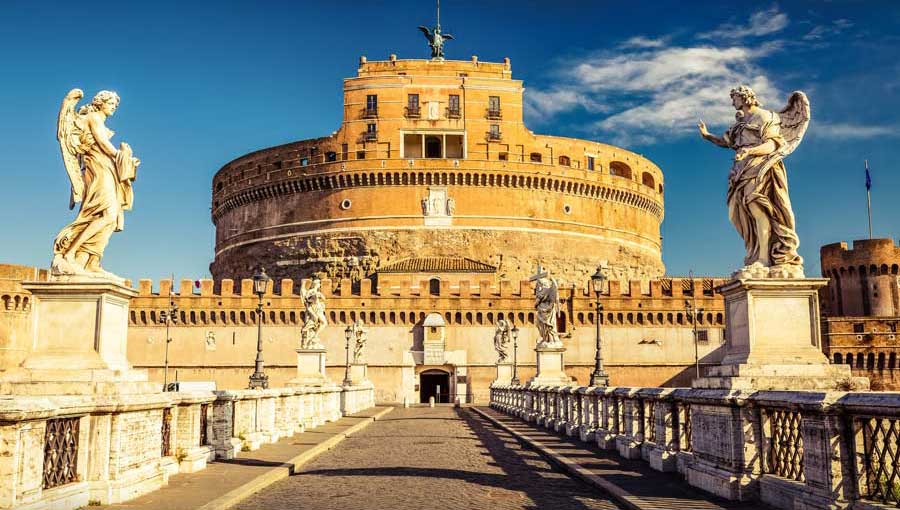
In the novel, Castel Sant’Angelo is the location of one of the major plot points. It is where Hassassin hides Vittoria. It is the place where Robert Langdon and Vittoria finally eliminate Hassassin.
The structure was originally commissioned by the Roman Emperor Hadrian in AD 135 as a mausoleum for himself and his family. After the fall of the Roman Empire, it was converted into a fortress and used as a castle by various popes over the centuries.
Brown’s vivid descriptions of the castle bring it to life in the minds of readers. He describes the castle’s towering walls, the moat surrounding it, and the ornate decorations adorning its façade. He also includes details about the Passetto di Borgo, which plays a crucial role in the story.
Brown also describes an underground tunnel connecting the Vatican to Castel Sant’Angelo which plays an important role in the plot.
While some aspects of the novel are fictional, Brown’s descriptions of the castle are based on its real-life history and architecture. His use of Castel Sant’Angelo as a setting has helped to increase the castle’s popularity and draw more tourists to the site. Today, Castel Sant’Angelo is a popular tourist attraction in Rome and houses a museum with a collection of artwork, weapons, and other historical artifacts.
The Sistine Chapel
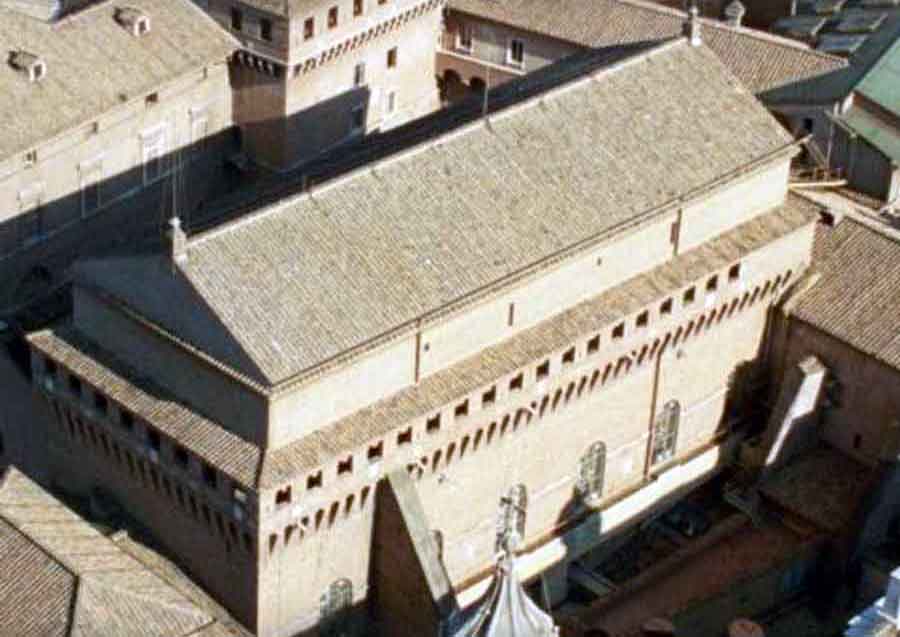
The Sistine Chapel is a famous chapel located in Vatican City, Italy. It was built in the late 15th century and was named after Pope Sixtus IV, who commissioned its construction.
This Chapel is a rectangular structure made of bricks, with six arched windows on each of its two major walls and a ceiling that is vaulted in the shape of a barrel. Although the front appears simple and lacking in ornamentation, the interior is lavishly embellished with frescoes created by numerous renowned Florentine Renaissance artists. The frescoes on the lateral walls were executed from 1481 to 1483. The north wall is adorned with six murals depicting various events from the life of Christ. Renowned artists such as Perugino, Pinturicchio, Sandro Botticelli, Domenico Ghirlandaio, and Cosimo Rosselli created these works of art. The south wall features six additional murals portraying various episodes from the life of Moses. Renowned artists like Perugino, Pinturicchio, Botticelli, Domenico and Benedetto Ghirlandaio, Rosselli, Luca Signorelli, and Bartolomeo della Gatta were responsible for creating these works of art. Adjacent to these murals, smaller artworks positioned among the windows depict several popes. At great ceremonial events, the lower sections of the side walls were decorated with a sequence of tapestries depicting events from the Gospels and the Acts of the Apostles. Raphael designed these tapestries, which were made in Brussels from 1515 until 1519.
The ceiling of the Sistine Chapel depicts scenes from the Bible, including the Creation of Adam and the Great Flood. The paintings are considered some of the greatest works of art in Western civilization and attract millions of visitors every year.
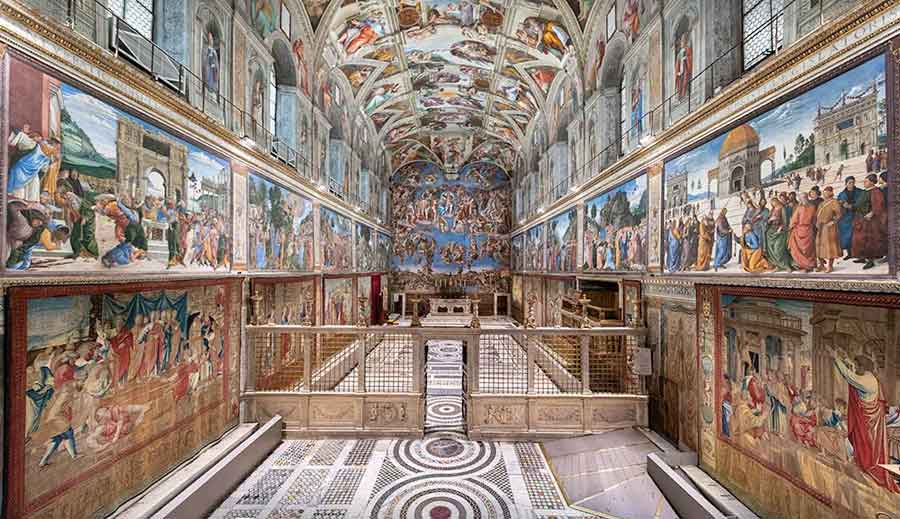
Visitors can view the Sistine Chapel as part of a tour of the Vatican Museums. However, photography is not allowed inside the chapel, and visitors are asked to maintain silence and respect the sacredness of the space.
Necropolis
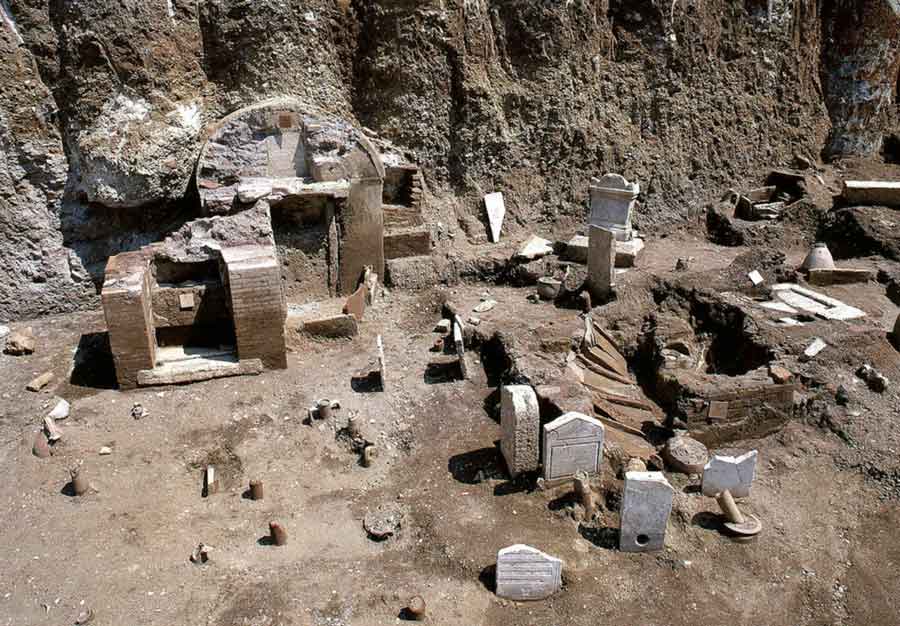
In Dan Brown’s novel “Angels and Demons,” the Necropolis is a hidden underground city located beneath Vatican City. It is an ancient Roman burial site that predates the construction of St. Peter’s Basilica. It contains tombs and mausoleums dating back to the 1st century AD, and is said to be the final resting place of St. Peter, the first pope. The Necropolis is located directly beneath the high altar of the Basilica and can only be accessed by special permission. The term “necropolis” is derived from the Greek words “nekros” (meaning “dead”) and “polis” (meaning “city”).
In the novel, the Necropolis plays a central role in the plot as the location of the antimatter bomb that threatens to destroy Vatican City. The main character, Robert Langdon, and his companion, Vittoria Vetra, must navigate the intricate maze of the Necropolis to locate and defuse the bomb before it detonates.
The papal conclave
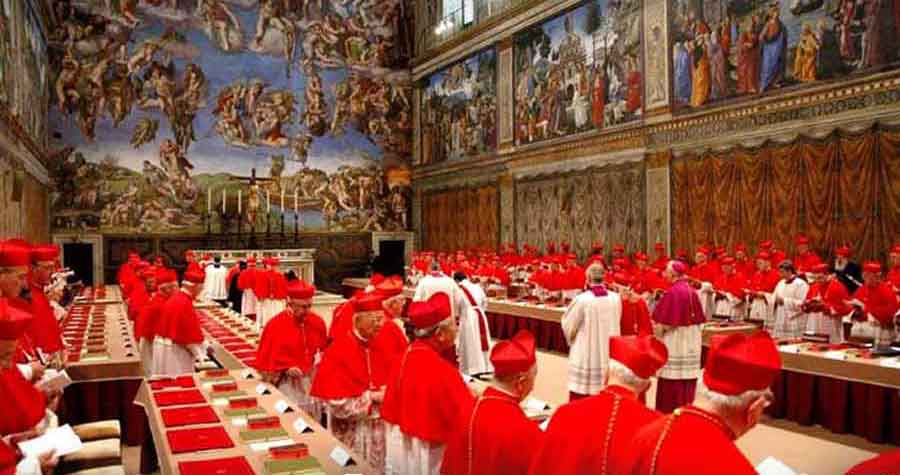
In Dan Brown’s novel “Angels and Demons,” the process of selecting a new pope in Vatican City is depicted as a complex and secretive ritual known as the papal conclave. The conclave is a gathering of the cardinals of the Catholic Church who are tasked with electing a new pope after the death or resignation of the previous pope.
The Sistine Chapel is the location of the papal conclave, the process by which a new pope is elected. During the conclave, the chapel is closed to the public and cardinals gather to vote for the next pope.
In the novel, the conclave is portrayed as a highly secretive process, with the cardinals being sequestered within the Sistine Chapel until a new pope is elected. During the conclave, the cardinals are not allowed to have contact with the outside world, and their communication devices are confiscated to ensure that the process is kept secret.
In order for a cardinal to be elected pope, he must receive a two-thirds majority of the votes cast by the cardinals in the conclave. Once a pope is elected, white smoke is released from the Sistine Chapel to signal the news to the waiting crowds outside.
It is worth noting that while the depiction of the papal conclave in “Angels and Demons” is based on some elements of truth, many aspects of the process are fictionalized or exaggerated for the sake of the novel. The actual conclave process is governed by strict rules and procedures set out by the Catholic Church.
The Pantheon
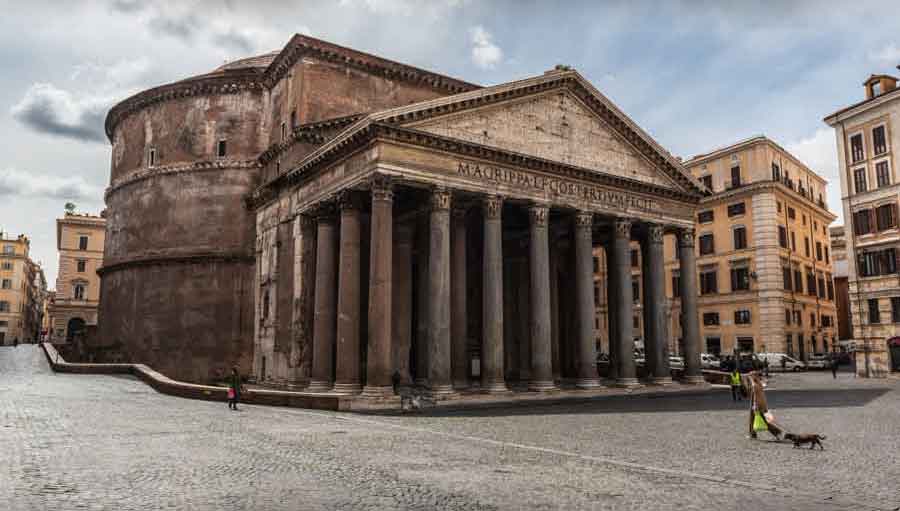
In the novel “Angels and Demons”, the Pantheon is described in detail as one of the key locations in the novel. The Pantheon is a former temple in Rome, Italy, dedicated to all the gods of pagan Rome. It was originally built by Marcus Agrippa in 27 BC but was later destroyed in a fire. The current structure was rebuilt by Emperor Hadrian in 126 AD and is considered one of the best-preserved ancient Roman buildings in the world.
Brown’s description of the Pantheon highlights its unique architectural features, including the massive dome that serves as the building’s roof. The dome is made of concrete and measures 142 feet in diameter, with a circular opening at the top called the oculus that provides natural light to the interior of the building. Brown notes that the oculus is the only source of light inside the Pantheon, creating an otherworldly atmosphere.
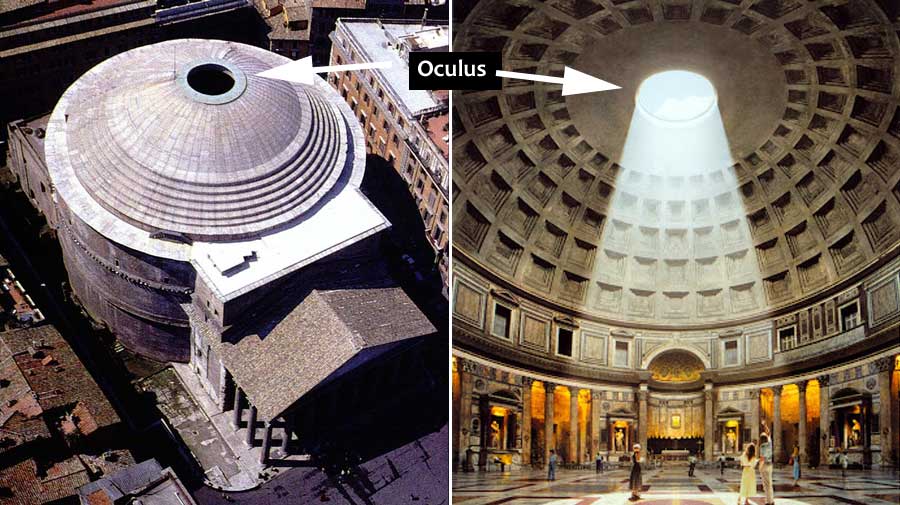
The author also mentions the Pantheon’s portico, which features sixteen granite columns that are each 39 feet tall and weigh over 60 tons. The columns support a triangular pediment adorned with sculptures of the gods and goddesses. Brown emphasizes the grandeur of the building’s exterior, noting that it was once covered in gold leaf and was the largest dome in the world until the Renaissance.
Inside the Pantheon, Brown describes the intricate marble flooring, which includes designs that create the illusion of depth and dimension. He also notes the various sculptures and altars dedicated to pagan gods and goddesses that once populated the temple. However, by the time of the events in the novel, the Pantheon had been converted into a church dedicated to the Virgin Mary and the martyrs.
The Pantheon was originally dedicated to all the gods of Ancient Rome but was later converted into a Christian church. Today, it remains an important cultural and historical landmark, attracting visitors from all over the world who come to marvel at its beauty and unique architectural design.
Bernini’s sculptures
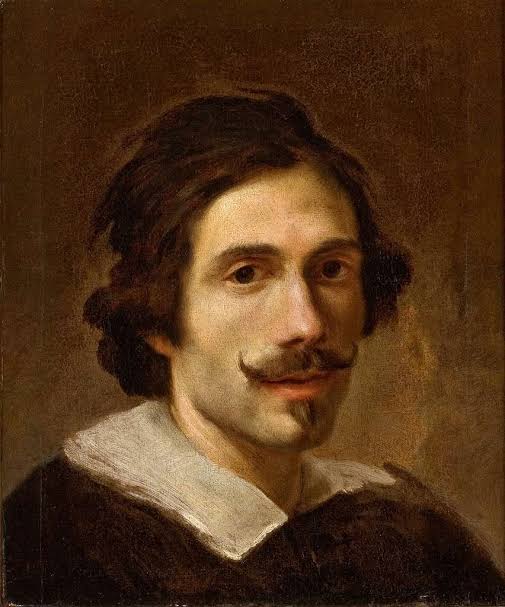
Gian Lorenzo Bernini (1598-1680) was an Italian sculptor, painter, and architect who is widely regarded as one of the leading figures of the Baroque period. Born in Naples and later based in Rome, Bernini’s work significantly shaped the city’s artistic and architectural landscape.
In “Angels and Demons,” Dan Brown describes several of Gian Lorenzo Bernini’s sculptures that are located in Rome. One of the most famous is the “Ecstasy of St. Teresa,” which is located in the Cornaro Chapel of the Church of Santa Maria della Vittoria. The sculpture depicts St. Teresa of Avila in a state of spiritual ecstasy as an angel pierces her heart with an arrow. The sculpture is known for its dramatic lighting, which gives the impression that the figures are illuminated from within.
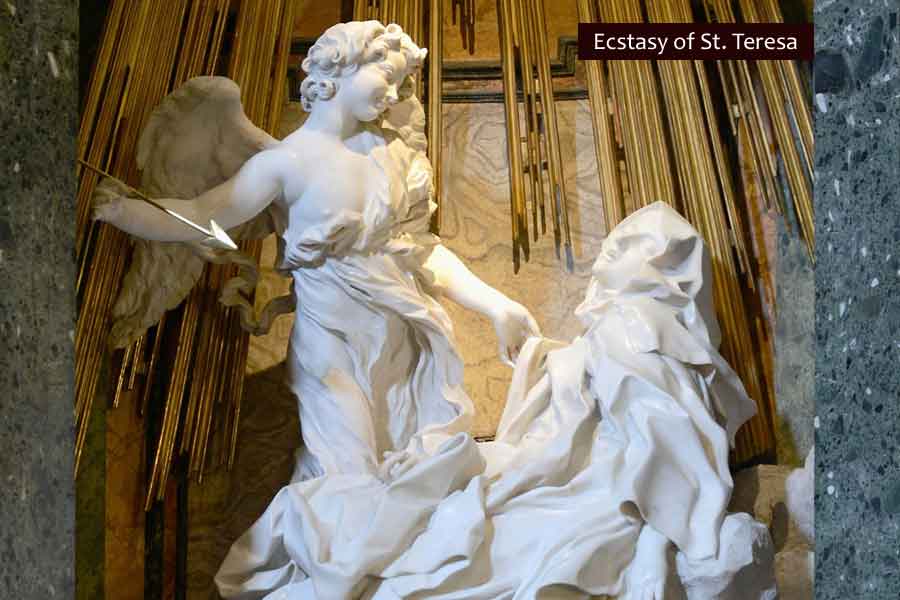
other Bernini sculpture described in the novel is the “Fontana dei Quattro Fiumi” (Fountain of the Four Rivers), which is located in the Piazza Navona. The fountain features four figures representing four rivers: the Nile, the Ganges, the Danube, and the Rio de la Plata. Each figure is accompanied by an animal that is native to the river it represents. The fountain is topped by an obelisk that was originally located in the Circus of Maxentius.
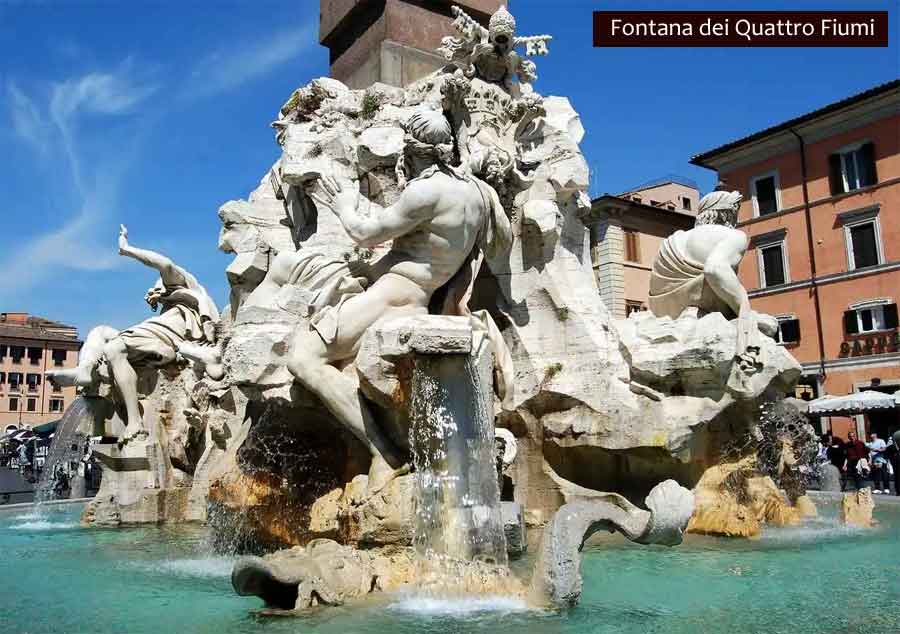
A third Bernini sculpture described in the novel is the “Altar of the Chair” in St. Peter’s Basilica. The altar features a large bronze chair that is supported by four figures representing the four evangelists: Matthew, Mark, Luke, and John. Above the chair is a stained glass window depicting the Holy Spirit in the form of a dove. The altar is meant to symbolize the authority of the Pope as the successor of St. Peter.
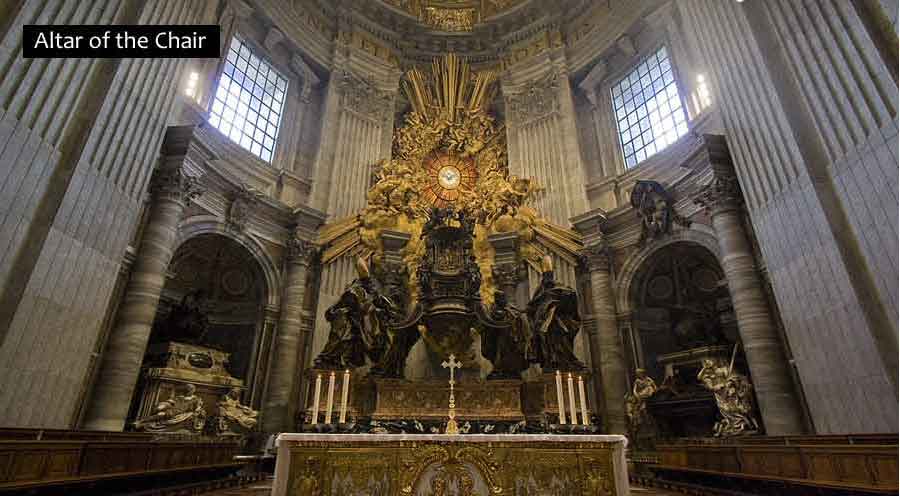
Swiss Guards
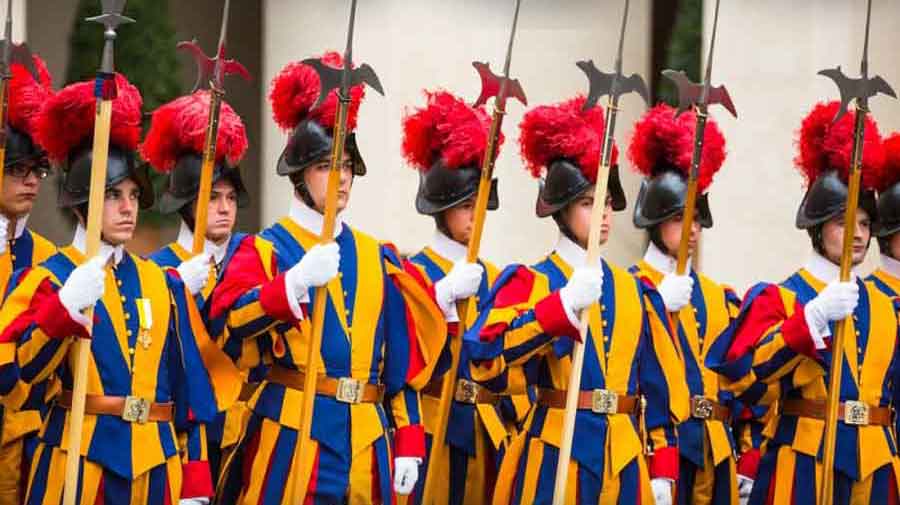
In “Angels and Demons,” the Swiss Guard is a central part of the story, as they are responsible for protecting the Vatican and its inhabitants. The Swiss Guard is a military unit that has been serving the Pope since the early 16th century, and they are known for their colorful and distinctive uniforms.
The Swiss Guard’s uniform consists of a blue, red, and yellow striped tunic, black pants, and a beret with the coat of arms of the Pope. They also wear a metal helmet with a distinctive red plume. The uniform is a symbol of the Swiss Guard’s loyalty and devotion to the Pope.
The Swiss Guard is trained in a variety of combat and defense techniques, including hand-to-hand combat and the use of firearms. They are also responsible for maintaining security within the Vatican, and they work closely with the Vatican Police to ensure the safety of the Pope and other dignitaries.
In “Angels and Demons,” the Swiss Guard is depicted as a formidable force, with their discipline and training on full display as they work to foil the plot to destroy the Vatican. Their role in the story adds to the sense of adventure and intrigue, and their loyalty and dedication to their duty is a source of inspiration.
The Illuminati
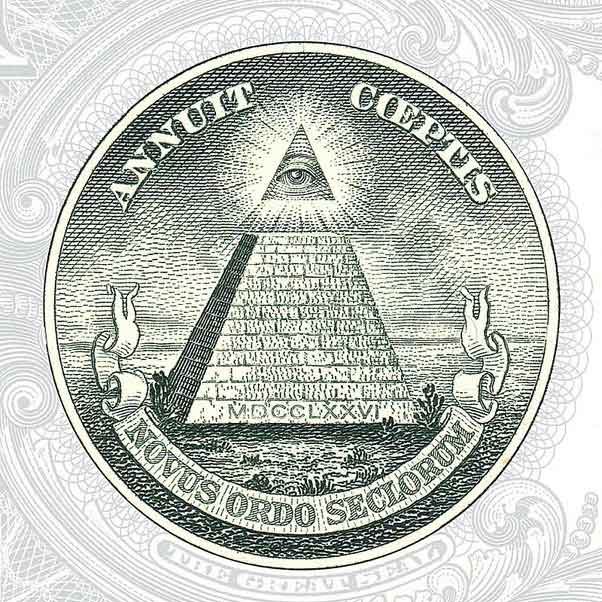
In “Angels and Demons”, the Illuminati is described as a secret society that was formed in the late 1500s by Galileo Galilei, a famous Italian physicist and astronomer. The group is said to have been made up of some of the most brilliant minds of the time, including scientists, artists, and philosophers.
According to the novel, the Illuminati was forced to go underground after being persecuted by the Catholic Church for their radical ideas and scientific beliefs. They are portrayed as having a deep hatred for the Church and as being determined to seek revenge for the persecution of their members.
In the novel, the Illuminati are depicted as having many of their rituals and symbols still shrouded in mystery. The group is portrayed as being ruthless and willing to do whatever it takes to achieve their goals, including using violence and murder and is also linked to the plot to destroy the Vatican with the antimatter bomb.
Ambigrams
An ambigram is a form of typographical art that retains meaning when viewed from different perspectives. This can involve the text appearing the same when rotated, reflected, or viewed upside down. Ambigrams play with symmetry, visual perception, and typography to create visually intriguing designs.
Types of Ambigrams
Rotational Ambigrams: These are the most common type. They can be read the same way upside down. Examples include words like “NOON” or “SWIMS”.
Mirror Ambigrams: These are symmetrical designs that read the same forwards and backward.
Multi-directional Ambigrams: These can be read in multiple directions, often requiring rotation.
Notable Ambigrams in “Angels and Demons”
In Dan Brown’s novel “Angels and Demons,” ambigrams play a significant and intriguing role. The use of ambigrams in “Angels and Demons” is a testament to Dan Brown’s skill as a writer, as well as his interest in symbols and hidden meanings. The ambigrams add a layer of complexity and intrigue to the story, and they require the reader to think critically and pay close attention to the details in order to unravel the plot.
The book showcases various ambigrams crafted by John Langdon, a renowned typographer. In addition to the ambigrams for “Angels & Demons” and “Illuminati,” the book features an ambigram of its own title on the hardcover book jacket and inside cover of the paperback editions.
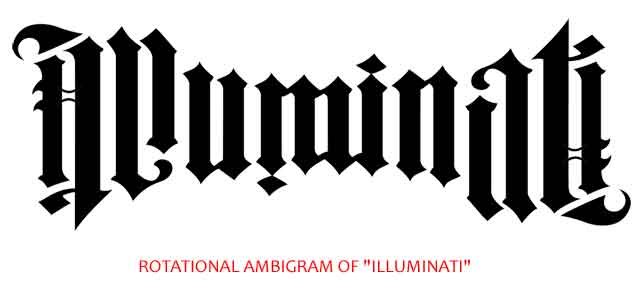
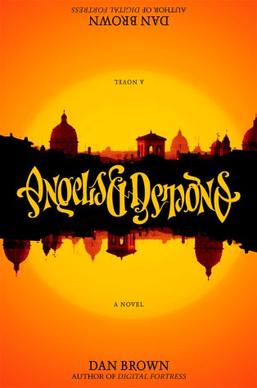
The title page of the hard-cover edition of the novel showing ambigram of ANGELS & DEMONS.
Furthermore, the book includes ambigrams for the words “Earth”, “Air”, “Fire”, and “Water”, which have helped popularize ambigram art due to the book’s widespread appeal

Among the ambigrams, there is one called the “Illuminati Diamond,” which cleverly represents the four elements arranged in a diamond shape.
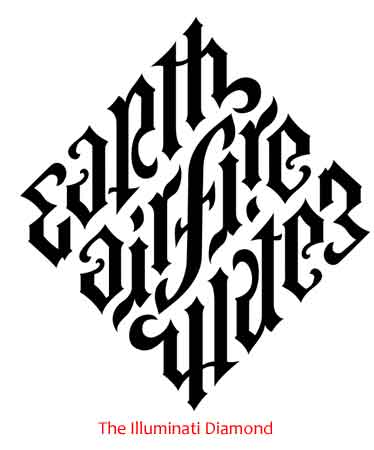
Overall, the use of symbols and mysteries in “Angels and Demons” is an effective tool for building tension and intrigue in the story. The use of ambigrams, the concept of the Illuminati, and the use of ancient elements all serve to add depth and complexity to the novel, and help to create a memorable reading experience.
The Path of Illumination and the four elements
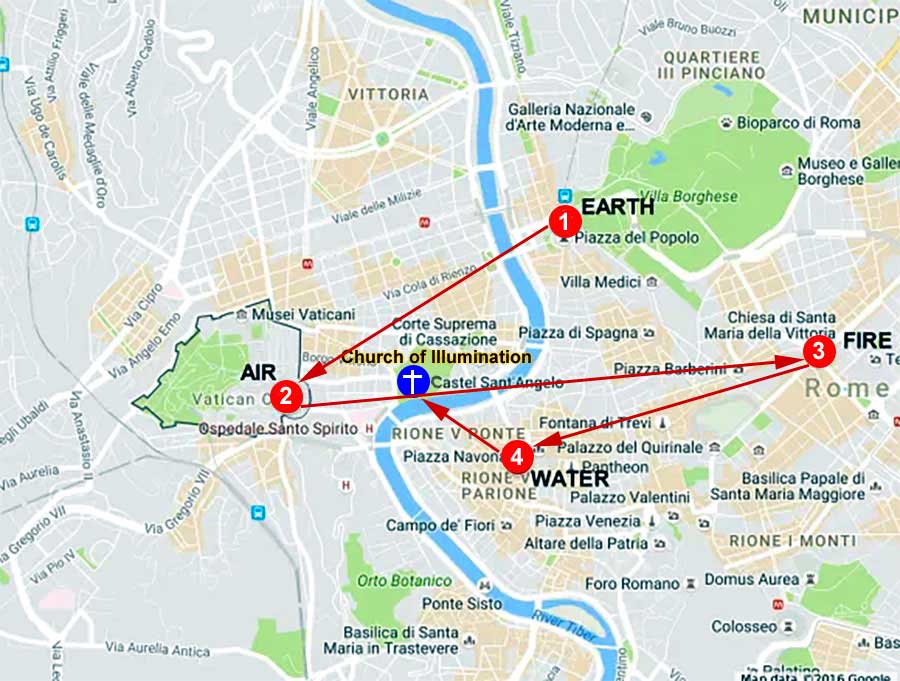
In “Angels and Demons,” the Path of Illumination is a series of clues and puzzles created by the Illuminati to lead Langdon and his team to the four altars of science, where they must locate and rescue the four kidnapped cardinals. The Path of Illumination is designed to test the intelligence and resourcefulness of those who seek to uncover the Illuminati’s plan, and it is filled with a variety of symbols and clues that must be deciphered in order to progress.
The clue to the Path of Illumination begins with four lines of Milton’s poem written on four sides of Galilio’s Diagramma folio, that Langdon and Vittoria stole from the Vatican Library, which contained clues that led Langdon and his team to the first altar of science. It contained the following four lines:
From Santi’s earthly tomb with demon’s hole,
‘Cross Rome the mystic elements unfold.
The path of light is laid, the sacred test,
Let angels guide you on your lofty quest
The first line of the poem points to Raphael Santi’s tomb, a renowned Italian painter and architect of the High Renaissance, as the beginning of the path of illumination.
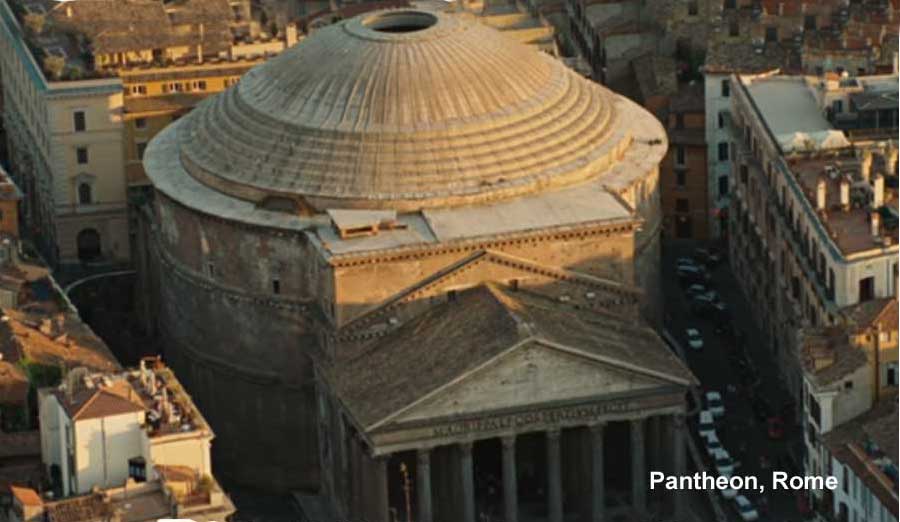
According to their information, Raphael’s tomb was in the Pantheon. However, it soon emerged that Raphael Santi passed away in 1520, and the Pantheon relocated his body in 1758. His original tomb was in the Chigi Chapel.
EARTH
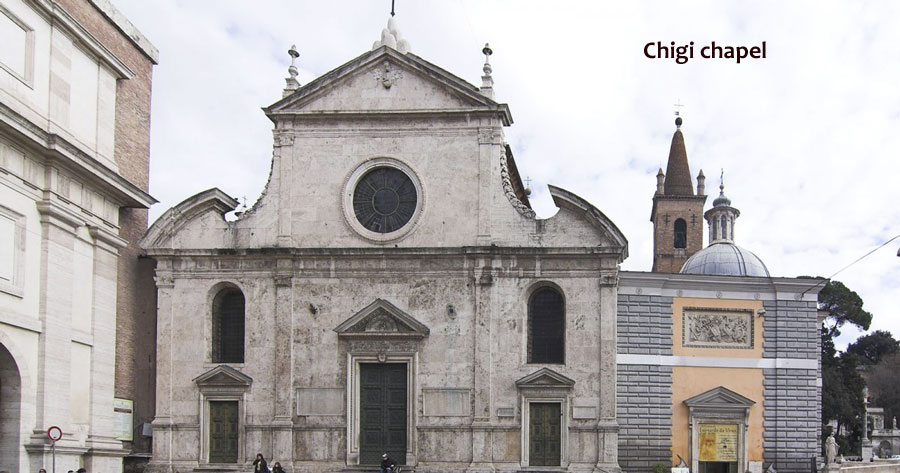
The first science altar honors the element Earth. This is the Chigi Chapel, commonly known as Capella della Terra or Chapel of the Earth! The chapel is located in the Basilica de Santa Maria del Popolo. The first cardinal is associated with the element of earth and his body is placed in the crypt of this chapel. He was branded with the ambigram EARTH on the chest.
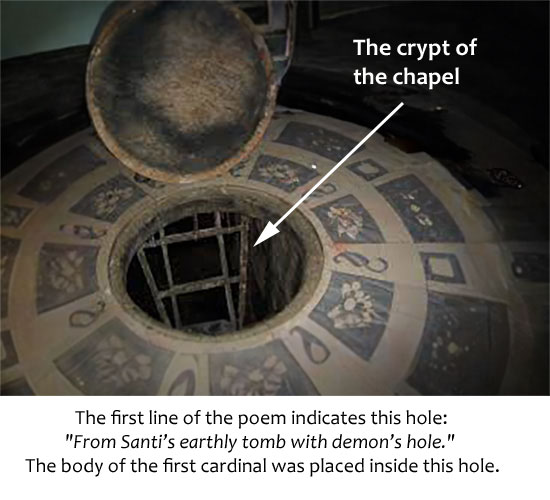
Inside the chapel, there is a sculpture of Habakkuk and an angel. The angel is pointing to the second altar. Since a document that Robert Langdon steals from the Vatican secret archives says, “Let the angels guide you on your lofty quest,” he may readily anticipate the direction of the second altar of science.
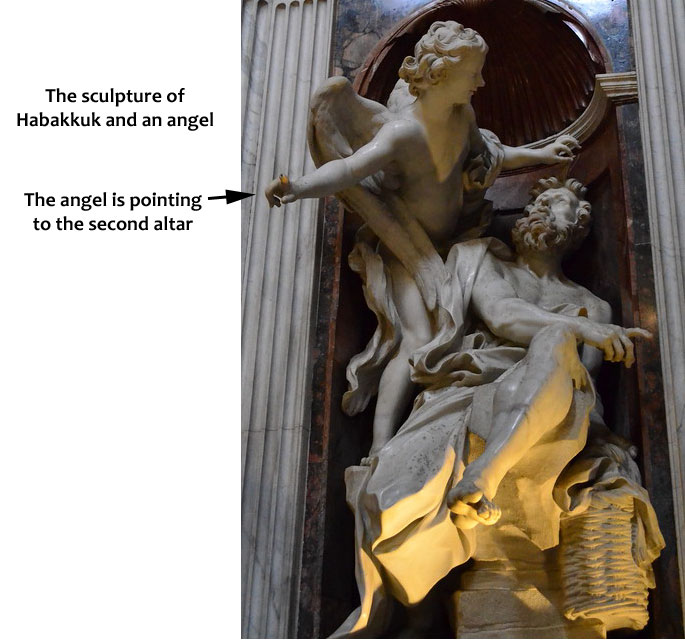
AIR
St. Peter’s Square in the Vatican is the second altar of science that honors the element air. The murder of the second cardinal occurs here, and the ambigram ‘AIR’ appears on his chest.
St. Peter’s Square is one of Bernini’s most recognizable masterpieces. There is a marker, which is a round slab on the ground bearing the words “West Ponente” and depicting an angel blowing air. The direction of the air leads Langdon to the third altar of science.
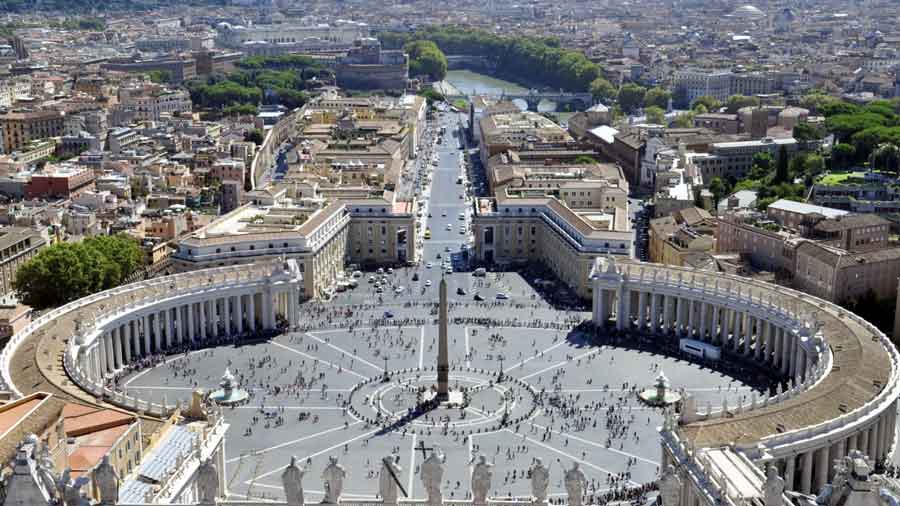
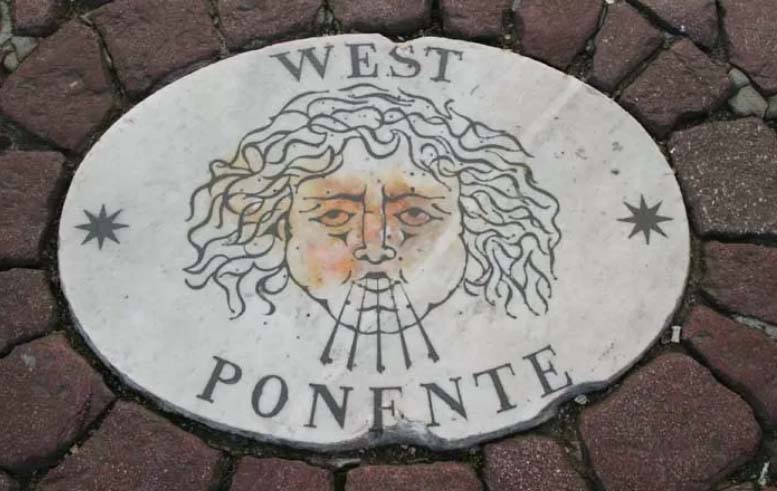
FIRE
The third altar of science is located inside the Santa Maria Della Vittoria church. Here the third cardinal is burned alive, and his chest was branded with the ambigram ‘FIRE’.
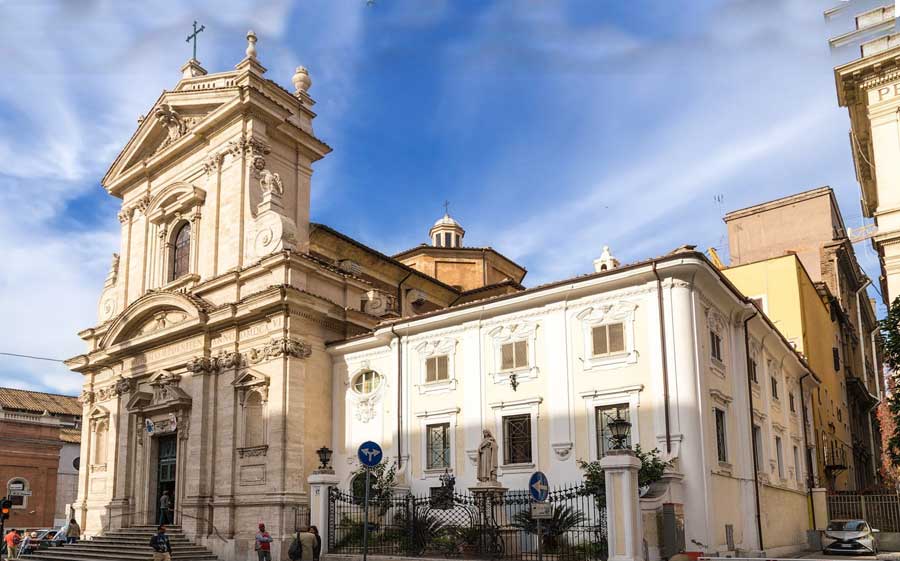
In this church, there is a baroque masterpiece by Bernini, “The Ecstasy of St. Teresa.” It shows an angel holding an arrow in his hand, and St. Teresa is in a state of ecstasy. The arrow in the angel’s hands points to the final altar.
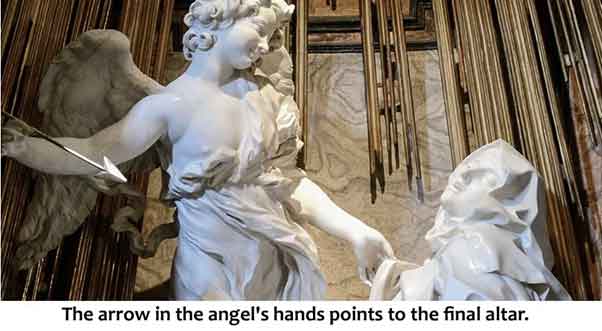
WATER
The fourth and last altar of science, representing water, is located at Piazza Navona. Bernini once again designed Fontana dei Quattro Fiumi, also known as the Fountain of the Four Rivers.
The fountain features four river gods representing the four major continents’ rivers: the Nile in Africa, the Ganges in Asia, the Danube in Europe, and the Rio de la Plata in America. The fourth cardinal drowns in water on this altar of science, his chest branded with the ambigram ‘WATER’.
There is an obelisk at the fountain. The dove perched atop the obelisk indicates the direction of the Castel Sant’ Angelo, which is the Church of Illumination.
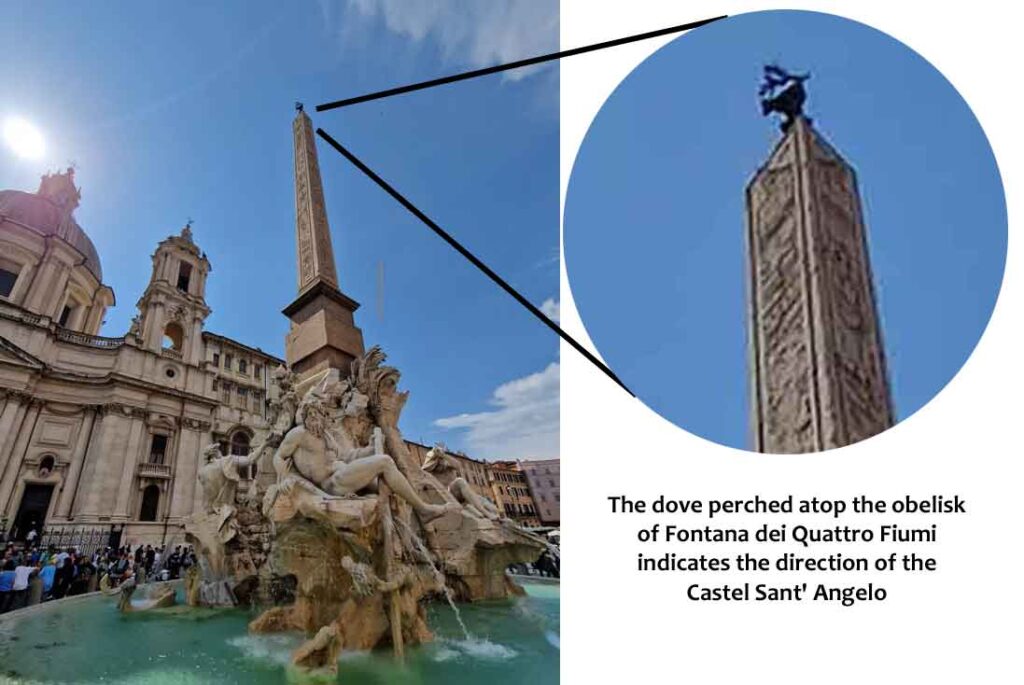
CHURCH OF ILLUMINATION:
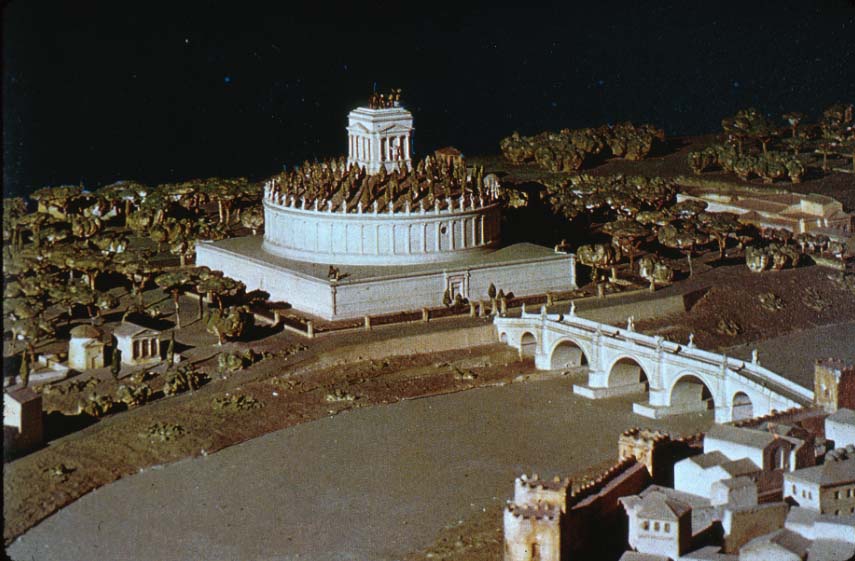
The “Church of Illumination” is eventually revealed to be the Castel Sant’Angelo in Rome. This historic fortress serves as the secret lair of the Illuminati in the novel “Angels and Demons.” It was the secret meeting place and hideout for the Illuminati members. What is interesting to note is the audacity of the Illuminati to design their lair right next to the Vatican. Castel Sant’ Angelo is now a museum, but it used to be a fortress for the Pope. The Passetto di Borgo, the secret passage that links the Vatican to Castel Sant’ Angelo, was used by the Pope as an escape route when in danger.
Castel Sant’Angelo, originally built as a mausoleum for Emperor Hadrian, has a rich history and symbolizes power and protection. In the novel, crucial confrontations and revelations occur. Robert Langdon and Vittoria Vetra follow the Path of Illumination, a trail marked by the four elements (earth, air, fire, and water), which leads them to this final location.
INTRODUCTION ![]() THEMES AND MOTIFS
THEMES AND MOTIFS ![]() CURIOSITY & SUSPENSE
CURIOSITY & SUSPENSE ![]() PLOT SUMMARY
PLOT SUMMARY
CRITICAL ANALYSIS ![]() IMPORTANT CHARACTERS
IMPORTANT CHARACTERS ![]() STRESSFUL MOMENTS & CLIFFHANGERS
STRESSFUL MOMENTS & CLIFFHANGERS

